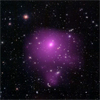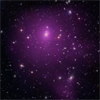CXC Home | Search | Help | Image Use Policy | Latest Images | Privacy | Accessibility | Glossary | Q&A
Tour of Abell 85
Quicktime MPEG
The composite image shows the galaxy cluster known as Abell 85, which is located about 740 million light years from Earth. The purple emission is multi-million degree gas detected in X-rays by NASA's Chandra X-ray Observatory, and the other colors show galaxies in an optical image from the Sloan Digital Sky Survey. This galaxy cluster is one of 86 observed by Chandra to trace how dark energy has stifled the growth of these massive structures over the last 7 billion years. Galaxy clusters are the largest collapsed objects in the Universe and are ideal for studying the properties of dark energy, the mysterious form of repulsive gravity that is driving the accelerated expansion of the Universe. Understanding the nature of dark energy is one of the biggest mysteries in science today.
[Runtime: 00:53]
Quicktime MPEG
The composite image shows the galaxy cluster known as Abell 85, which is located about 740 million light years from Earth. The purple emission is multi-million degree gas detected in X-rays by NASA's Chandra X-ray Observatory, and the other colors show galaxies in an optical image from the Sloan Digital Sky Survey. This galaxy cluster is one of 86 observed by Chandra to trace how dark energy has stifled the growth of these massive structures over the last 7 billion years. Galaxy clusters are the largest collapsed objects in the Universe and are ideal for studying the properties of dark energy, the mysterious form of repulsive gravity that is driving the accelerated expansion of the Universe. Understanding the nature of dark energy is one of the biggest mysteries in science today.
[Runtime: 00:53]
Credits: X-ray (NASA/CXC/SAO/A.Vikhlinin et al.); Optical (SDSS);
Images of Galaxy Cluster in Dark Energy Study
Quicktime MPEG
This one galaxy cluster is representative of over 80 clusters that were used to track the effects of dark energy on these massive objects over time. First shown in optical light, this galaxy cluster, Abell 85, is then seen in X-ray light from NASA's Chandra X-ray Observatory. Most of the matter in galaxy clusters is in the form of very hot gas, which emits copious amounts of X-rays. By studying clusters across large distances, astronomers have determined that dark energy has stifled their growth.
[Runtime: 00:10]
Quicktime MPEG
This one galaxy cluster is representative of over 80 clusters that were used to track the effects of dark energy on these massive objects over time. First shown in optical light, this galaxy cluster, Abell 85, is then seen in X-ray light from NASA's Chandra X-ray Observatory. Most of the matter in galaxy clusters is in the form of very hot gas, which emits copious amounts of X-rays. By studying clusters across large distances, astronomers have determined that dark energy has stifled their growth.
[Runtime: 00:10]
Credits: X-ray (NASA/CXC/SAO/A.Vikhlinin et al.); Optical (SDSS)
Simulation of Growth of Structures
Quicktime MPEG
The simulation shows how the Universe has evolved from soon after the Big Bang to the present day. As the Universe expanded and cooled, matter began to clump together due to the effects of gravity, and large structures such as galaxies and clusters of galaxies formed, over billions of years. This growth has been suppressed by dark energy over the last 5 billion years, as the expansion of the Universe accelerates, so that observations of the growth of galaxy clusters with Chandra over this time span can measure the properties of dark energy.
[Runtime: 01:27]
Quicktime MPEG
The simulation shows how the Universe has evolved from soon after the Big Bang to the present day. As the Universe expanded and cooled, matter began to clump together due to the effects of gravity, and large structures such as galaxies and clusters of galaxies formed, over billions of years. This growth has been suppressed by dark energy over the last 5 billion years, as the expansion of the Universe accelerates, so that observations of the growth of galaxy clusters with Chandra over this time span can measure the properties of dark energy.
[Runtime: 01:27]
(Credits: MPE/V.Springel)
Comparing of Expansion of Universe and Growth of Structures
Quicktime MPEG
This pair of illustrations shows the change in scale of the Universe over cosmic time, followed by the change in the weight of a typical galaxy cluster over the same time frame. The orange line shows the evolution of the observed Universe, with dark energy and cosmic acceleration, and the yellow and blue lines show high and low density models that do not contain dark energy. The observed change in weight of galaxy clusters over the last 7 billion years agrees very well with predictions for a Universe dominated by dark energy.
[Runtime: 00:18]
Quicktime MPEG
This pair of illustrations shows the change in scale of the Universe over cosmic time, followed by the change in the weight of a typical galaxy cluster over the same time frame. The orange line shows the evolution of the observed Universe, with dark energy and cosmic acceleration, and the yellow and blue lines show high and low density models that do not contain dark energy. The observed change in weight of galaxy clusters over the last 7 billion years agrees very well with predictions for a Universe dominated by dark energy.
[Runtime: 00:18]
(Credit: NASA/CXC/M.Weiss)
Return to Dark Energy (December 16, 2008)






